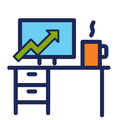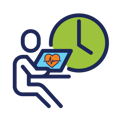Let’s start off on the right foot
“You are so much sunshine in every square inch.” —Walt Whitman

The skinny
During the pandemic, we experienced the equivalent of five years of digital growth in eight weeks of time, as many first-time digital users began relying on technology to get what they needed.
♥
Cool beans.
Way cooler than beans. In the last six months of the pandemic, nearly 70 million more people across Europe used digital services for their first time. And more than 30% of Americans say they are online almost constantly now, a 10 percentage-point jump from 2015.
Breaking the digital divide.
For sure. Now, many older Americans are putting on their readers and opening apps to order groceries, video chat with doctors, and connect with loved ones online.
Getting hip to the know!
A story from A to Z. The digitization of many tasks should be an indication as to how people may want (read: prefer) to interact with online technology moving forward.
Expand.
Well, let’s face it, we’re in a whole new world. Grandma likes to order takeout now and Gramps is Zooming better than the rest of us. It might be time to rethink how organizations communicate with their employees. Instead of reverting back to the “olden days” of paper and snail mail, perhaps leaning into this digital revolution will result in more engaged employees, despite age or digital prowess.
We’re all digital natives now.
Yes, and with that comes a particular challenge. Now that so many more people are comfortable getting digital, delivering a better user experience is going to be the #1 challenge.
I need **seamless** darling.
Seamless is key here. A fluid experience where users can get what they need, where they need it, and get help from a human if they need it—without leaving their screens/phones/computers—is a chef’s kiss-type of digital experience all HR leaders need to think about.
Date with data: 22% of 50–60-year-olds go online “almost constantly,” up from only 12% in 2015.
Double date: US adults added 1 hour of digital time in 2020, surpassing 3 hours a day for the first time.
Further reading: Pandemics, plagues, and innovation in history: the striking parallels between COVID-19 and the Black Death.
Consider virtual: Connecting Benefits in a Virtual World.
The skinny
New report indicates that individuals who regularly work long hours are more susceptible to heart disease and stroke.
♥
That’s heart stopping.
Pun intended. The report found that those who work 55+ hours a week routinely are more susceptible and that 5% of deaths are related to behavior changes caused by overwork, including unhealthy diet, poor sleep, and reduced activity.
Scary.
Indeed. The reason these numbers are so concerning is because many employees across the country are being required to work longer hours because of massive hiring shortages. That, and increased demands from a recovering economy.
See what my thumb and my finger are playing?
Man, tough love. Before you play an encore, also think about the productivity toll of overwork. Do you really think 100 hours of work equates to better work?
No?
More isn’t always better. And it’s not just people returning to the office who are having to put in longer hours. Many employees who work from home have also had issues with “turning work off.”
Well, what now?
Wellness. It’s in organizations’ best interest to address workload as part of well-being initiatives before employees start to quit. And, if overtime is necessary to keep the boat afloat, a good rule of thumb is to allow employees to choose when they want to work those extra hours. Lord knows everyone has their own priorities. Many employees are ok with burning the midnight oil if their main priorities outside of work are met.
Totes quotes: “There was a point where I was not eating, showering, or doing anything else other than working from morning until after midnight.” –Goldman Sachs analyst
Wise words: “Busyness is not a means to accomplishment, but an obstacle to it.” –Alex Soojung-Kim Pang, Stanford scholar and author
Further reading: Chinese Millennials are “laying flat” in direct rebellion of “work hard” society.

The skinny
"Imposter syndrome" is something that many employees suffer from and it can not only hinder growth, but also innovation and overall mental health.
♥
Explain.
Well, have you ever had the feeling that you’ve been asked to do something you’re not qualified for–and it’s just a matter of time before everyone realizes it? Or maybe you believe that your achievement relies on luck, fantastic timing, or even tricking others into getting where you’re at?
Triggered.
Don’t worry, you’re not alone. Celebrities, they’re just like us! And many famous people and politicians have openly admitted to feeling fraudy.
Any advice?
Sharing is caring. Talking about your insecurities is an important step in beating imposter syndrome. Surround yourself with other people who are willing to talk openly about their careers, lives, and doubts.
Ok, make friends, what else?
Stop being afraid to fail (aka ditch the perfectionism). And, even if you do end up failing (as all of us do), change the narrative to “Oh shucks I failed,” to, “I’m still learning.”
Thank you for that.
You’re ahead of the game on this one. Accepting compliments is very hard for those with imposter syndrome. Before you deflect, deflate, or make a joke about a compliment, practice those two simple winning words.
Further listening: TED-Ed – Combating Imposter Syndrome.
Further Reading: Stop Telling Women They Have Imposter Syndrome.
 Now a break from the news… |
Compliance Corner |
Here’s something to…
- MF Celebrate: Giant pandas are no longer endangered.
- Pet: Many employees are choosing pets over jobs.
- Consider: Is Thursday the new Monday?
- Not Cook: 30 no-cook recipes for too-hot summers.
- Get done: 5 habits productive people use to get the important stuff done.
|

Benefits Insight Dashboard
Employees in manufacturing have a higher risk tolerance than those in admin.
|
|



